ART NEWS:Jan.04
 Since the invention of the moving image, women have created films and videos that have changed how people see and experience the world. Throughout 2021, the Smithsonian will celebrate the breadth of women-made films and videos through a monthly program series called “Viewfinder: Women’s Film and Video from the Smithsonian.” On the first Thursday of each month, the Smithsonian will host a free online screening of rarely seen short films and videos from its collections followed by live conversations with the artists and Smithsonian curators. Each screening will include an audience Q&A, and a recording of the program will be available for the remainder of each month on womenshistory.si.edu. The selected works featured in “Viewfinder” will explore different themes that connect collections across several Smithsonian museums. The first six programs of the year will feature works that examine inner worlds—a timely topic as the global pandemic continues to confine many people to their homes. Info: Duration: 7/1-30/12/2021, womenshistory.si.edu
Since the invention of the moving image, women have created films and videos that have changed how people see and experience the world. Throughout 2021, the Smithsonian will celebrate the breadth of women-made films and videos through a monthly program series called “Viewfinder: Women’s Film and Video from the Smithsonian.” On the first Thursday of each month, the Smithsonian will host a free online screening of rarely seen short films and videos from its collections followed by live conversations with the artists and Smithsonian curators. Each screening will include an audience Q&A, and a recording of the program will be available for the remainder of each month on womenshistory.si.edu. The selected works featured in “Viewfinder” will explore different themes that connect collections across several Smithsonian museums. The first six programs of the year will feature works that examine inner worlds—a timely topic as the global pandemic continues to confine many people to their homes. Info: Duration: 7/1-30/12/2021, womenshistory.si.edu
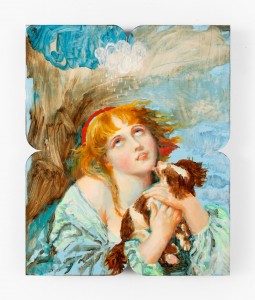 Tursic & Mille’s works in the exhibition “Encounter” is like swimming in a swamp of images. There is no hierarchy between the two; both of them call the shots, and the various elements in the pictures are results of conversations and mutual resistance. But there are more voices and exchanges than just their own. They also incorporate others’ visual languages: many of the paintings and sculptural works appropriate existing images besides using images found online, they also cut out pages from magazines, and allow these to collect paint and dust in the studio, effectively producing new traces and destroying the images. In turn and before long, the images cease to exist as fast moving consumer goods, and just as quickly become objects as such, living an afterlife, going in parallel with Tursic & Mille’s artistic practice that, based upon existing images, marks, unmarks and remarks traces in a language that is similar to Polke’s, Richter’s and Ruscha’s. Info: Almine Rech Gallery, 27 Huqiu Road, 2nd Floor, Shanghai, Duration: 15/1-6/3/2021, Days & Hours: Tue-Sat 11:00-19:00, www.alminerech.com
Tursic & Mille’s works in the exhibition “Encounter” is like swimming in a swamp of images. There is no hierarchy between the two; both of them call the shots, and the various elements in the pictures are results of conversations and mutual resistance. But there are more voices and exchanges than just their own. They also incorporate others’ visual languages: many of the paintings and sculptural works appropriate existing images besides using images found online, they also cut out pages from magazines, and allow these to collect paint and dust in the studio, effectively producing new traces and destroying the images. In turn and before long, the images cease to exist as fast moving consumer goods, and just as quickly become objects as such, living an afterlife, going in parallel with Tursic & Mille’s artistic practice that, based upon existing images, marks, unmarks and remarks traces in a language that is similar to Polke’s, Richter’s and Ruscha’s. Info: Almine Rech Gallery, 27 Huqiu Road, 2nd Floor, Shanghai, Duration: 15/1-6/3/2021, Days & Hours: Tue-Sat 11:00-19:00, www.alminerech.com
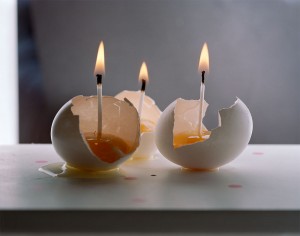 Torbjørn Rødland in his exhibition “Bible Eye” features a selection of recent and earlier works alongside new photographs created in Austin. Torbjørn Rødland continues his work with analog technology and readymade spaces to create photographs that render the everyday uncanny. His images blend the cool, seductive aestheticism of commercial and fashion photography with the layered complexity of a conceptual practice, resulting in ambivalent perspectives that both attract and repulse. This contradictory stance is intentional, the artist’s careful positioning of his work within a fugitive field. From the media-savvy reality critique of 1980s Pictures Generation–era artists, , to the seemingly captured moments of Nan Goldin and Larry Clark or the rigorous conceptualism of Christopher Williams and John Baldessari, practitioners working in photography in recent decades have sought to upend notions of authorship and originality in representational imagery while grappling with the concerns of conceptualism within a medium that is inherently grounded in reality. Concurrently, the advent of digital photography has both expedited and removed uncertainty from the process, rendering the analog formats Rødland uses a specialization. Info: Curator: Heather Pesanti, The Contemporary Austin, Jones Center, 700 Congress Ave, Austin, Duration: 23/1-15/8/2021, Days & Hours: Thu & Sun 12:00-17:00, Fri-Sat 12:00-19:00 )Advanced ticket reservations required) https://thecontemporaryaustin.org
Torbjørn Rødland in his exhibition “Bible Eye” features a selection of recent and earlier works alongside new photographs created in Austin. Torbjørn Rødland continues his work with analog technology and readymade spaces to create photographs that render the everyday uncanny. His images blend the cool, seductive aestheticism of commercial and fashion photography with the layered complexity of a conceptual practice, resulting in ambivalent perspectives that both attract and repulse. This contradictory stance is intentional, the artist’s careful positioning of his work within a fugitive field. From the media-savvy reality critique of 1980s Pictures Generation–era artists, , to the seemingly captured moments of Nan Goldin and Larry Clark or the rigorous conceptualism of Christopher Williams and John Baldessari, practitioners working in photography in recent decades have sought to upend notions of authorship and originality in representational imagery while grappling with the concerns of conceptualism within a medium that is inherently grounded in reality. Concurrently, the advent of digital photography has both expedited and removed uncertainty from the process, rendering the analog formats Rødland uses a specialization. Info: Curator: Heather Pesanti, The Contemporary Austin, Jones Center, 700 Congress Ave, Austin, Duration: 23/1-15/8/2021, Days & Hours: Thu & Sun 12:00-17:00, Fri-Sat 12:00-19:00 )Advanced ticket reservations required) https://thecontemporaryaustin.org
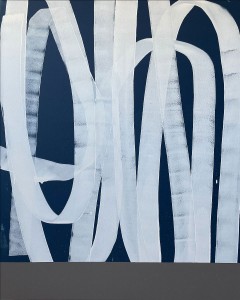 Philip A. Zimmermann’s exhibition “I would prefer not to / ich möchte lieber nicht”, borrows its title from a personal artefact the artist found at a local flea market in his neighbourhood. The white and immaculate space of the gallery becomes an essential part for the presentation of his work which is controlled by form, colors, lines on many different levels and horizons. As the area of a canvas is already limited, he usually adds further limits by interrupting the image or reducing it. The monochrome bars are part of the painting and somehow not. The beams can give some paintings the calm they need. His works on paper and photographs are linked to the loneliness and isolation humans are experiencing in life; while his paintings are the result of his multidisciplinary creative process. The content of his oeuvre deals with experiences, moods and feelings he’s been confronted with. His works serves as the documentation of our rapidly changing time. Info: Bernier/Eliades Gallery, 46 Rue du Châtelain, Brussels, Duration: 26/1-3/4/2021, Days & Hours: Tue-Sat 11:00-18:00, https://bernier-eliades.com
Philip A. Zimmermann’s exhibition “I would prefer not to / ich möchte lieber nicht”, borrows its title from a personal artefact the artist found at a local flea market in his neighbourhood. The white and immaculate space of the gallery becomes an essential part for the presentation of his work which is controlled by form, colors, lines on many different levels and horizons. As the area of a canvas is already limited, he usually adds further limits by interrupting the image or reducing it. The monochrome bars are part of the painting and somehow not. The beams can give some paintings the calm they need. His works on paper and photographs are linked to the loneliness and isolation humans are experiencing in life; while his paintings are the result of his multidisciplinary creative process. The content of his oeuvre deals with experiences, moods and feelings he’s been confronted with. His works serves as the documentation of our rapidly changing time. Info: Bernier/Eliades Gallery, 46 Rue du Châtelain, Brussels, Duration: 26/1-3/4/2021, Days & Hours: Tue-Sat 11:00-18:00, https://bernier-eliades.com
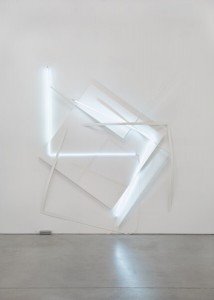 François Morellet’s solo exhibition “In-Coherent” underscores the full breadth of the artist’s artistic explorations through a large array of mediums. The exhibition begins with works from the 1950s, a period during which Morellet turned from figurative and representational work to abstraction following an influential trip to Brazil in 1950. Inspired by his first encounters there with Concrete art and the work of Max Bill, he began creating works that followed simple systems and rules and eliminated as many arbitrary decisions as possible. His “Trames” paintings feature, for example, superimposed grids of perpendicular lines or networks of dashes rotated at various angles. These early works also expose Morellet’s intent to use descriptive titles containing the information necessary for the viewer to understand the rule behind the creation of the work. Morellet eventually went beyond the confines of the picture plane and in the 1970s became interested in what he called ‘the outside of painting,’ focusing on three-dimensionality and introducing steel, iron, wire, mesh, and later wood into his work. In the 1980s Morellet explored relief paintings containing irregularly shaped elements, often natural material culled from outside. Info: Hauser & Wirth Gallery, 32 East 69th Street, New York, Duration: 26/1-7/4/2021, Days & Hours: Tue-Sat 10:00-18:00, www.hauserwirth.com
François Morellet’s solo exhibition “In-Coherent” underscores the full breadth of the artist’s artistic explorations through a large array of mediums. The exhibition begins with works from the 1950s, a period during which Morellet turned from figurative and representational work to abstraction following an influential trip to Brazil in 1950. Inspired by his first encounters there with Concrete art and the work of Max Bill, he began creating works that followed simple systems and rules and eliminated as many arbitrary decisions as possible. His “Trames” paintings feature, for example, superimposed grids of perpendicular lines or networks of dashes rotated at various angles. These early works also expose Morellet’s intent to use descriptive titles containing the information necessary for the viewer to understand the rule behind the creation of the work. Morellet eventually went beyond the confines of the picture plane and in the 1970s became interested in what he called ‘the outside of painting,’ focusing on three-dimensionality and introducing steel, iron, wire, mesh, and later wood into his work. In the 1980s Morellet explored relief paintings containing irregularly shaped elements, often natural material culled from outside. Info: Hauser & Wirth Gallery, 32 East 69th Street, New York, Duration: 26/1-7/4/2021, Days & Hours: Tue-Sat 10:00-18:00, www.hauserwirth.com
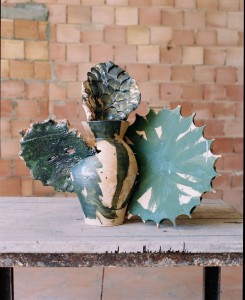 Miquel Barceló’s solo exhibition “Metamorphosis” takes its name from Franz Kafka’s famous story, published in 1915. The show comprises almost 100 works made between 2014 and 2020, a selection of works: 30 ceramics, 13 paintings, 42 watercolours, 6 travel logs and a small sculpture, along with an installation comprising 7 large 7 large bronzes that will be set up in the central courtyard of the Museo Picasso Málaga. Mutation, mobility and transition are just some the characteristics of the Majorcan artist’s work, and his creative world corroborates his permanent metamorphosis since the beginning of his career. The passage of time and material alchemy are prominent elements in the theme of the exhibition. The exhibition focuses on the artist’s culturally nomadic nature. It is also a critical view of creation as a project of unlimited progress: each of his works leads us to another, in a cyclical process of reinvention. Based on the reality that he sees, experiences, reads about and imagines, his representations contain sociological and ecological nuances, while also expressing a passionate inner life. Info: Curator: Enrique Juncosa, Museo Picasso Málaga, Duration: 27/1-30/9/2021, Days & Hours: Daily (November-February: 11:00-17:00, March-June: 11:00-18:00, July-August: 11:00-19:00, September-October: 11:00-18:00, www.museopicassomalaga.org
Miquel Barceló’s solo exhibition “Metamorphosis” takes its name from Franz Kafka’s famous story, published in 1915. The show comprises almost 100 works made between 2014 and 2020, a selection of works: 30 ceramics, 13 paintings, 42 watercolours, 6 travel logs and a small sculpture, along with an installation comprising 7 large 7 large bronzes that will be set up in the central courtyard of the Museo Picasso Málaga. Mutation, mobility and transition are just some the characteristics of the Majorcan artist’s work, and his creative world corroborates his permanent metamorphosis since the beginning of his career. The passage of time and material alchemy are prominent elements in the theme of the exhibition. The exhibition focuses on the artist’s culturally nomadic nature. It is also a critical view of creation as a project of unlimited progress: each of his works leads us to another, in a cyclical process of reinvention. Based on the reality that he sees, experiences, reads about and imagines, his representations contain sociological and ecological nuances, while also expressing a passionate inner life. Info: Curator: Enrique Juncosa, Museo Picasso Málaga, Duration: 27/1-30/9/2021, Days & Hours: Daily (November-February: 11:00-17:00, March-June: 11:00-18:00, July-August: 11:00-19:00, September-October: 11:00-18:00, www.museopicassomalaga.org
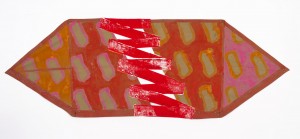 Claude Viallat, an iconic figure of French contemporary art, is taking over the vast space of Galerie Templon on Rue du Grenier Saint-Lazare for the first time with “Sutures and Varia”, a radical exhibition that defies the codes of painting, volume and space. A member and founding-member of the avant-garde Supports/Surfaces movement in the 1970s, Claude Viallat has established himself as a leading figure in French painting. For nearly half a century, he has spurned stretchers and canvases, instead painting on unstructured or juxtaposed textiles, endlessly repeating the same motif in a palette of shimmering colors. The exhibition offers a selection of works painted in the last two years. The new “Sutures” series, elaborated during the recent lockdowns, is anchored for the first time in a reflection on the notion of junction. Fabrics with unusual contours and textures are assembled, as if “sutured” by strips of fabric with floral patterns. These sutures, simultaneously friezes and bandages, are laid loose or carefully folded with glue by the artist. Info: Galerie Templon, 28 rue du Grenier Saint-Lazare, Paris, Duration: 30/1-20/3/2021, Days & Hours: Tue-Sat 10:00-19:00, https://www.templon.com/new/current.php?la=en
Claude Viallat, an iconic figure of French contemporary art, is taking over the vast space of Galerie Templon on Rue du Grenier Saint-Lazare for the first time with “Sutures and Varia”, a radical exhibition that defies the codes of painting, volume and space. A member and founding-member of the avant-garde Supports/Surfaces movement in the 1970s, Claude Viallat has established himself as a leading figure in French painting. For nearly half a century, he has spurned stretchers and canvases, instead painting on unstructured or juxtaposed textiles, endlessly repeating the same motif in a palette of shimmering colors. The exhibition offers a selection of works painted in the last two years. The new “Sutures” series, elaborated during the recent lockdowns, is anchored for the first time in a reflection on the notion of junction. Fabrics with unusual contours and textures are assembled, as if “sutured” by strips of fabric with floral patterns. These sutures, simultaneously friezes and bandages, are laid loose or carefully folded with glue by the artist. Info: Galerie Templon, 28 rue du Grenier Saint-Lazare, Paris, Duration: 30/1-20/3/2021, Days & Hours: Tue-Sat 10:00-19:00, https://www.templon.com/new/current.php?la=en
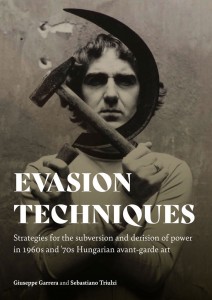 The catalogue “Evasion techniques. Strategies for the subversion and derision of power in 1960s and ‘70s Hungarian avant-garde art” covers and illustrates the show of the same name which was held at Rome’s Palazzo delle Esposizioni, dedicated to a selection of those extraordinary avant-garde artists who found themselves operating in conditions of danger, inhibiting control and censorship, under a totalitarian communist regime, even at risk of their own safety. Through their brave and desperate attempts to express themselves and to disobey, their adventure enables us to experience a crucial chapter in art history. The catalogue, which you can now download for free, is a universal investigation into the condition of art under all systems of power. Each chapter provides us with an instruction book of “evasion techniques,” offering a glimpse at images, actions, traces of performances held clandestinely and under the very nose of the authorities, driven by the sole urgency of actually doing them. In this way we encounter and get to know a number of highly important artists, from Endre Tót to Judit Kele, Sándor Pinczehelyi, Bálint Szombathy, András Baranyay, Tibor Csiky, Katalin Ladik, László Lakner, Dóra Maurer, Gyula Gulyás, Ferenc Ficzek, Tamás St. Auby (Szentjóby), Gábor Bódy, Marcel Odembach, Gyula Pauer, Zsigmond Károlyi, Tibor Hajas, László Beke, István B. Gellér, György Kemény, Kálmán Szijártó, Gábor Attalai, Károly Halász, László Haris and Orsolya Drozdik.
The catalogue “Evasion techniques. Strategies for the subversion and derision of power in 1960s and ‘70s Hungarian avant-garde art” covers and illustrates the show of the same name which was held at Rome’s Palazzo delle Esposizioni, dedicated to a selection of those extraordinary avant-garde artists who found themselves operating in conditions of danger, inhibiting control and censorship, under a totalitarian communist regime, even at risk of their own safety. Through their brave and desperate attempts to express themselves and to disobey, their adventure enables us to experience a crucial chapter in art history. The catalogue, which you can now download for free, is a universal investigation into the condition of art under all systems of power. Each chapter provides us with an instruction book of “evasion techniques,” offering a glimpse at images, actions, traces of performances held clandestinely and under the very nose of the authorities, driven by the sole urgency of actually doing them. In this way we encounter and get to know a number of highly important artists, from Endre Tót to Judit Kele, Sándor Pinczehelyi, Bálint Szombathy, András Baranyay, Tibor Csiky, Katalin Ladik, László Lakner, Dóra Maurer, Gyula Gulyás, Ferenc Ficzek, Tamás St. Auby (Szentjóby), Gábor Bódy, Marcel Odembach, Gyula Pauer, Zsigmond Károlyi, Tibor Hajas, László Beke, István B. Gellér, György Kemény, Kálmán Szijártó, Gábor Attalai, Károly Halász, László Haris and Orsolya Drozdik.
